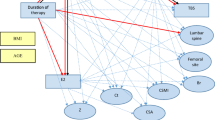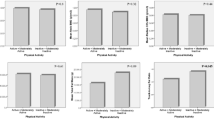Abstract
Although hypogonadism is a risk factor for bone loss and fractures, the different etiopathophysiology and hormonal profile of classical and obesity-induced hypogonadism may lead to differences in musculoskeletal profile. This is a cross-sectional study of hypogonadal men between 40 and 74 years old. Our outcomes include: areal bone mineral density (aBMD) and body composition by dual-energy X-ray absorptiometry; volumetric BMD (vBMD) and soft tissue composition of the tibia by peripheral quantitative computed tomography. Fracture risk assessment tool (FRAX) scores were evaluated. Testosterone, estradiol, luteinizing hormone, follicle stimulating hormone, sex hormone-binding globulin, C-telopeptide, osteocalcin, and sclerostin were measured. We divided the population into subgroups of BMI: group 1: BMI < 30; group 2: BMI ≥30 to <35 and group 3: BMI ≥ 35 kg/m2. One-hundred five men were enrolled. Spine and hip aBMD, and total and trabecular vBMD at the 4% tibia significantly increased with increasing BMI. Cortical thickness (330.7 ± 53.2, 343.3 ± 35.4, and 358.7 ± 38.2 mm, p = 0.04; groups 1, 2 and 3, respectively) and cortical area (5.3 ± 0.7, 5.5 ± 0.6, and 5.7 ± 0.6 mm, p = 0.01; groups 1, 2 and 3, respectively) at 38% tibia increased with increasing BMI. While absolute lean mass increased with increasing BMI, % lean mass and muscle density (70.2 ± 5.0, 71.3 ± 6.4, and 67.1 ± 5.1 mg/cm3; groups 1, 2 and 3, respectively) were lowest in group 3. Although severely obese hypogondal men have better BMD and bone quality, they have reduced muscle density, the significance of which remains to be determined.

Similar content being viewed by others
References
Barrett-Connor E, Mueller JE, von Muhlen DG et al (2000) Low levels of estradiol are associated with vertebral fractures in older men, but not women: the Rancho Bernardo Study. J Clin Endocrinol Metab 85:219–223
Khosla S, Melton LJ III, Atkinson EJ et al (1998) Relationship of serum sex steroid levels and bone turnover markers with bone mineral density in men and women: a key role for bioavailable estrogen. J Clin Endocrinol Metab 83:2266–2274
Falahati-Nini A, Riggs BL, Atkinson EJ et al (2000) Relative contributions of testosterone and estrogen in regulating bone resorption and formation in normal elderly men. J Clin Invest 106:1553–1560
Reid IR (2002) Relationships among body mass, its components, and bone. Bone 31:547–555
Kirschner MA, Schneider G, Ertel NH et al (1982) Obesity, androgens, estrogens and cancer risk. Cancer Res 42:3281s–3285s
Schneider G, Kirschner MA, Berkowitz R et al (1979) Increased estrogen production in obese men. J Clin Endocrinol Metab 48:633–638
Strain GW, Zumoff B, Kream J et al (1982) Mild Hypogonadotropic hypogonadism in obese men. Metabolism 31:871–875
Bhasin S, Cunningham GR, Hayes FJ et al (2010) Testosterone therapy in men with androgen deficiency syndromes: an endocrine society clinical practice guideline. J Clin Endocrinol Metab 95:2536–2559
Aguirre LE, Colleluori G, Fowler KE et al (2015) High aromatase activity in hypogonadal men is associated with higher spine bone mineral density, increased truncal fat and reduced lean mass. Eur J Endocrinol 173:167–174
Aguirre L, Napoli N, Waters D et al (2014) Increasing adiposity is associated with higher adipokine levels and lower bone mineral density in obese older adults. J Clin Endocrinol Metab 99:3290–3297
Dennison EM, Jameson KA, Edwards MH et al (2014) Peripheral quantitative computed tomography measures are associated with adult fracture risk: the Hertfordshire Cohort Study. Bone 64:13–17
Wong AK, Beattie KA, Min KK et al (2014) Peripheral quantitative computed tomography-derived muscle density and peripheral magnetic resonance imaging-derived muscle adiposity: precision and associations with fragility fractures in women. J Musculoskelet Neuronal Interact 14:401–410
Sherk VD, Thiebaud RS, Chen Z et al (2014) Associations between pQCT-based fat and muscle area and density and DXA-based total and leg soft tissue mass in healthy women and men. J Musculoskelet Neuronal Interact 14:411–417
Frank-Wilson AW, Johnston JD, Olszynski WP et al (2015) Measurement of muscle and fat in postmenopausal women: precision of previously reported pQCT imaging methods. Bone 75:49–54
Napoli N, Villareal DT, Mumm S et al (2005) Effect of CYP1A1 gene polymorphisms on estrogen metabolism and bone density. J Bone Miner Res 20:232–239
Vermeulen A, Verdonck L, Kaufman JMA (1999) Critical evaluation of simple methods for the estimation of free testosterone in serum. J Clin Endocrinol Metab 84:3666–3672
Sowers MR, Randolph J Jr, Jannausch M et al (2008) Levels of sex steroid and cardiovascular disease measures in premenopausal and hormone-treated women at midlife: implications for the “timing hypothesis”. Arch Intern Med 168:2146–2153
Giagulli VA, Kaufman JM, Vermeulen A (1994) Pathogenesis of the decreased androgen levels in obese men. J Clin Endocrinol Metab 79:997–1000
Glass AR, Swerdloff RS, Bray GA et al (1977) Low serum testosterone and sex hormone-binding globulin in massively obese men. J Clin Endocrinol Metab 45:1211–1219
Amatruda JM, Hochstein M, Hsu TH et al (1982) Hypothalamic and pituitary dysfunction in obese males. Int J Obes 6:183–189
Kley HK, Deselaers T, Peerenboom H et al (1980) Enhanced conversion of androstenedione to estrogens in obese males. J Clin Endocrinol Metab 51:1128–1132
Zumoff B, Miller LK, Strain GW (2003) Reversal of the hypogonadotropic hypogonadism of obese men by administration of the aromatase inhibitor testolactone. Metabolism 52:1126–1128
Corona G, Monami M, Rastrelli G et al (2011) Type 2 diabetes mellitus and testosterone: a meta-analysis study. Int J Androl 34:528–540
Dhindsa S, Miller MG, McWhirter CL et al (2010) Testosterone concentrations in diabetic and nondiabetic obese men. Diabetes Care 33:1186–1192
Albala C, Yanez M, Devoto E et al (1996) Obesity as a protective factor for postmenopausal osteoporosis. Int J Obes Relat Metab Disord 20:1027–1032
Felson DT, Zhang Y, Hannan MT et al (1993) Effects of weight and body mass index on bone mineral density in men and women: the Framingham Study. J Bone Miner Res 8:567–573
Khosla S, Melton LJ III, Robb RA et al (2005) Relationship of volumetric BMD and structural parameters at different skeletal sites to sex steroid levels in men. J Bone Miner Res 20:730–740
Nielson CM, Marshall LM, Adams AL et al (2011) BMI and fracture risk in older men: the osteoporotic fractures in men study (MrOS). J Bone Miner Res 26:496–502
Shen J, Nielson CM, Marshall LM et al (2015) The Association Between BMI and QCT-Derived Proximal Hip Structure and Strength in Older Men: a Cross-Sectional Study. J Bone Miner Res 30:1301–1308
Taes YE, Lapauw B, Vanbillemont G et al (2009) Fat mass is negatively associated with cortical bone size in young healthy male siblings. J Clin Endocrinol Metab 94:2325–2331
De Laet C, Kanis JA, Oden A et al (2005) Body mass index as a predictor of fracture risk: a meta-analysis. Osteoporos Int 16:1330–1338
Estrada M, Kleppinger A, Judge JO et al (2007) Functional impact of relative vs. absolute sarcopenia in healthy older women. J Am Geriatr Soc 55:1712–1719
Kalinkovich A, Livshits G (2017) Sarcopenic obesity or obese sarcopenia: a cross talk between age-associated adipose tissue and skeletal muscle inflammation as a main mechanism of the pathogenesis. Ageing Res Rev 35:200–221
Goodpaster BH, Carlson CL, Visser M et al (1985) Attenuation of skeletal muscle and strength in the elderly: the Health ABC Study. J Appl Physiol 90:2157–2165
Villareal Dennis T, Banks Marian, Siener Catherine et al (2004) Physical frailty and body composition in obese elderly men and women. Obes Res 12:913–920
Herrera-Rangel AB, Aranda-Moreno C, Mantilla-Ochoa T et al (2015) Influence of the body mass index on the occurrence of falls in patients with type 2 diabetes mellitus. Obes Res Clin Pract 9(5):522–526
Compston J (2015) Obesity and fractures in postmenopausal women. Curr Opin Rheumatol 27:414–419
Baumgartner RN, Koehler KM, Gallagher D et al (1998) Epidemiology of sarcopenia among the elderly in New Mexico. Am J Epidemiol 147:755–763
Batsis JA, Mackenzie TA, Lopez-Jimenez F et al (2015) Sarcopenia, sarcopenic obesity and functional impairments in older adults: National Health and Nutrition Examination Surveys 1999–2004. Nutr Res 35:1031–1039
Ng M, Fleming T, Robinson M et al (2014) Global, regional, and national prevalence of overweight and obesity in children and adults during 1980–2013: a systematic analysis for the Global Burden of Disease Study 2013. Lancet 384:766–781
Lamm S, Chidakel A, Bansal R (2016) Obesity and hypogonadism. Urol Clin North Am 43:239–245
Kaplan SA, Lee JY, O’Neill EA et al (2013) Prevalence of low testosterone and its relationship to body mass index in older men with lower urinary tract symptoms associated with benign prostatic hyperplasia. Aging Male 16:169–172
Acknowledgements
This study was supported by the resources at the New Mexico VA Health Care System in Albuquerque, NM, USA; the Biomedical Research of New Mexico Albuquerque, NM, USA; the Michael E. DeBakey VA Medical Center, Houston, TX, USA and the Center for Translational Research in Inflammatory Diseases (CTRID) at the Michael E. DeBakey VA Medical Center, Houston, TX.
Funding
This work was funded by VA Merit Review 5 101 CX00042403.
Author information
Authors and Affiliations
Contributions
Author Contributions
RAV designed the study. LA, GC, RD, DR, DV, RAV conducted the study and collected the data. LA, GC, CQ, DV, RAV analyzed and interpreted the data. LA, GC, RC, BJ, CQ, DV, RV drafted the manuscript. Revising manuscript content and approving the final version: all take responsibility for the manuscript content, the integrity of the data analysis and approval of the final version of the manuscript.
Corresponding author
Ethics declarations
Conflict of interest
Lina E. Aguirre, Georgia Colleluori, Richard Dorin, David Robbins, Rui Chen, Bryan Jiang, Clifford Qualls, Dennis T. Villareal, Reina Armamento-Villareal declare that they have no conflict of interest.
Human and Animal Rights and Informed Consent
All procedures performed in studies involving human participants were in accordance with the ethical standards of the institutional and/or national research committee and with the 1964 Helsinki declaration and its later amendments or comparable ethical standards.
Additional information
Lina E. Aguirre and Georgia Colleluori contributed equally to this manuscript and are considered as co-first authors.
Rights and permissions
About this article
Cite this article
Aguirre, L.E., Colleluori, G., Dorin, R. et al. Hypogonadal Men with Higher Body Mass Index have Higher Bone Density and Better Bone Quality but Reduced Muscle Density. Calcif Tissue Int 101, 602–611 (2017). https://doi.org/10.1007/s00223-017-0316-x
Received:
Accepted:
Published:
Issue Date:
DOI: https://doi.org/10.1007/s00223-017-0316-x




